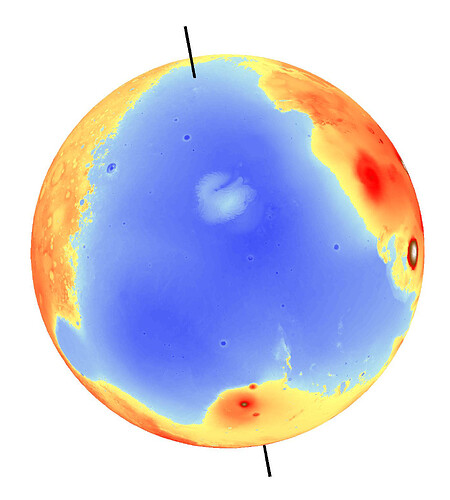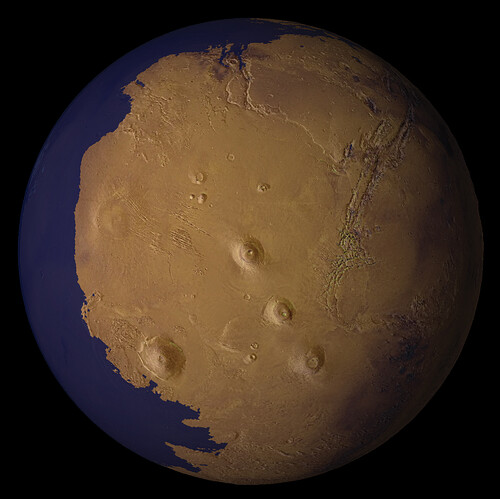Media Relations
University of California-Berkeley
Media Contacts: Robert Sanders
(510) 643-6998 / (510) 642-3734
Additional Resources:
Taylor Perron, (617) 495-4687
Michael Manga, (510) 643-8532
Mark Richards, (510) 642-5872
Jerry Mitrovica, (416) 978-4946
FOR IMMEDIATE RELEASE: Wednesday, June 13, 2007
Strong evidence that Mars once had an ocean
A paper in this week’s issue of Nature by University of California,
Berkeley, geophysicists demolishes one of the key arguments against the past
presence of large oceans on Mars.
Even from Earth, a large plain surrounding the planet’s north pole looks
like a sediment-filled ocean basin. In the 1980s, Viking spacecraft images
revealed two possible ancient shorelines near the pole, each thousands of
kilometers long with features like those found in Earth’s coastal regions.
The shorelines – Arabia and the younger Deuteronilus – date from between 2
and 4 billion years ago.
In the 1990s, however, NASA’s Mars Global Surveyor mapped the Martian
topography to a resolution of 300 meters, and found that the shoreline
varies in elevation by several kilometers (more than a mile), rising and
falling like a wave with several thousand kilometers from one peak to the
next. Because shoreline elevations on Earth, measured relative to sea level,
are typically constant, many experts rejected the notion that Mars once had
oceans.
UC Berkeley scientists have now discovered that these undulating Martian
shorelines can be explained by the movement of Mars’ spin axis, and thus its
poles, by nearly 3,000 kilometers along the surface sometime within the past
2 or 3 billion years. Because spinning objects bulge at their equator, this
so-called “true polar wander” could have caused shoreline elevation shifts
similar to those observed on Mars.
“When the spin axis moves relative to the surface, the surface deforms, and
that is recorded in the shoreline,” said study coauthor Michael Manga, UC
Berkeley professor of earth and planetary science.
“On planets like Mars and Earth that have an outer shell, or lithosphere,
that behaves elastically, the solid surface will deform differently than the
sea surface, creating a non-uniform change in the topography,” added primary
author Taylor Perron, a former UC Berkeley graduate student now a
postdoctoral fellow in Harvard University’s Department of Earth and
Planetary Sciences.
Perron’s calculations show that the resistance of Mars’ elastic crust could
create several-kilometer elevation differences for features like a
shoreline, in accord with topographic measurements. The Arabia shoreline
varies in elevation by about 2.5 kilometers, while the Deuteronilus
shoreline varies by about 0.7 kilometers.
“This is a beautiful result that Taylor got. The mere fact that you can
explain a good fraction of the information about the shorelines with such a
simple model is just amazing. It’s something I never would have guessed at
the outset,” said co-author Mark Richards, professor of earth and planetary
science and dean of mathematical and physical sciences at UC Berkeley.
Richards goes so far as to add, “This really confirms that there was an
ocean on Mars.”
Richards pointed out that the tilt of the rotation axis of a planet actually
remains fixed relative to the sun, but the crust moves relative to this
axis. The question remains: What caused Mars’ rotation axis to move relative
to the crust?
Any major shift of mass on a planet – within the mantle, or between the
mantle and the crust to form a volcano, or even via impact from outer space
– could cause a shift of the rotation axis because a spinning planet is
most stable with its mass farthest from its spin axis. Richards has modeled
true polar wander in Earth’s past that was generated by the upwelling of hot
mantle in the interior of the planet, which some scientists claim shifted
our planet’s rotation axis 90 degrees some 800 million years ago, tipping
the planet on its side.
Perron, Manga, Richards and their colleagues calculate that on Mars, an
initial shift of 50 degrees from today’s pole, equal to about 3,000
kilometers on the surface, would be sufficient to disrupt the Arabia
shoreline, while a subsequent shift of 20 degrees from today’s pole, or 700
kilometers, would have altered the Deuteronilus shoreline.
Interestingly, today’s pole and the two ancient poles lie in a straight line
equidistant from the planet’s biggest feature, the Tharsis rise, a bulge
just north of the equator that contains Mars’ most recent volcanic vent,
Olympus Mons. Tharsis is the largest volcano in the solar system, and formed
about 4 billion years ago, not long after Mars solidified. Dynamically, the
relative positions of Tharsis and the pole path is exactly what would be
expected for any mass shift on Mars that is smaller than the Tharsis rise,
since the planet would reorient in a way that keeps Tharsis on the equator.
“This alignment is unlikely to occur by coincidence,” the team wrote.
Manga has a hunch about the mass shift that precipitated the tilt of Mars’
rotation axis. If a flood of water had filled the Arabia ocean about 3
billion years ago, to a depth some have calculated at up to several
kilometers, that mass at the pole might have been enough to shift the pole
50 degrees to the south. Once the water disappeared, the pole could have
shifted back, then shifted again by 20 degrees during the deluge that
created the Deuteronilus shoreline.
Because it’s unclear whether the two shorelines represent separate
inundations or whether one is the receded shoreline of a larger sea, an
alternative scenario features the Arabia ocean receding to the Deuteronilus
shoreline, shifting the pole from 50 to 20 degrees. Then, once the Arabia
ocean disappears entirely, the pole returns to its current position.
Richards is skeptical of this, however, pointing out that thermal convection
within the hot interior of Mars could also have caused the poles to wander.
“There must certainly be thermal convection in Mars now because Olympus Mons
had new lava flows very recently, within the last 100 million years,” he
said. “But the jury’s still out.”
Manga said, too, that the source of the water, while unknown, must have
produced a deluge greater than any observed on Earth, since huge canyons are
cut in the flanks of the Tharsis rise. The water may have evaporated, but it
may also have sunk back into underground dikes, frozen near the surface but
possibly liquid below.
The study, whose coauthors include Jerry X. Mitrovica and Isamu Matsuyama,
will appear in the June 14 issue of the British journal Nature. Mitrovica,
who is with the Department of Physics at the University of Toronto in
Ontario, Canada, and was a visiting Miller Professor at UC Berkeley, and
Matsuyama, who is with the Department of Terrestrial Magnetism at the
Carnegie Institution of Washington in Washington, D.C., have developed
models for the effect of polar wander and internal dynamic processes on the
surface deformation of Mars.
The work is part of UC Berkeley’s BioMars project, funded by NASA’s
Astrobiology Institute (http://cips.berkeley.edu/biomars/). The research
also was supported by UC Berkeley’s Miller Institute for Basic Research in
Science, the Natural Sciences and Engineering Research Council of Canada and
the NASA Mars Data Analysis Program.
IMAGE CAPTIONS:
[Image 1:
(780KB)]
[Image 2:
(1.3MB)]
A view of Mars as it might have appeared more than 2 billion years ago, with
a low-latitude ocean filling the lowland basin that now occupies the north
polar region. Topographic deformation of features that ring the basin, which
are hypothesized to be shorelines formed by an ancient ocean, suggests that
Mars experienced significant true polar wander – reorientation of the
planet relative to its rotation axis – that brought the planet into its
present rotational state. The margins of the ocean shown here account for
the topographic deformation that would have resulted from this
reorientation. Sinuous features near the top of the image are valleys carved
by large floods that may have supplied the ocean water. The image was
generated using Viking Orbiter images and topographic data from the Mars
Orbiter Laser Altimeter on board the Mars Global Surveyor spacecraft.
Credit: Taylor Perron/UC Berkeley

